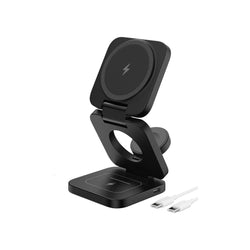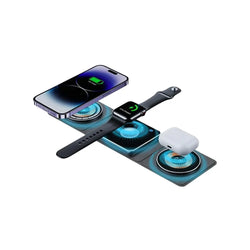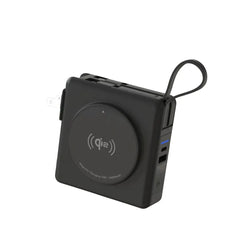As our lives become more mobile and digital, staying connected is essential. Whether you’re commuting, traveling, attending meetings, or simply out for the day, your smartphone or device is your lifeline. Running out of battery can be frustrating and sometimes even critical. That’s where portable wireless power banks come into play. These advanced tools offer freedom from wall outlets and cables, providing effortless power whenever and wherever you need it. This article provides an in-depth look at everything you need to know about portable wireless power banks, including their operation, key benefits, and essential features to consider when making a purchase. If you're looking to stay powered on the move, this guide is for you.
What Are Portable Wireless Power Banks?
Portable wireless power banks are compact battery-powered devices that allow you to charge your electronic devices wirelessly using electromagnetic induction. Unlike traditional power banks that require a charging cable to connect your phone or tablet, these modern versions let you simply place your device on the power bank surface to start charging. These power banks typically utilise Qi wireless charging technology, the same standard employed by many modern smartphones from Apple, Samsung, Google, and other manufacturers. Many models also include USB ports so you can charge multiple devices simultaneously, both wirelessly and via cable.
How Do Portable Wireless Power Banks Work?
A portable wireless power bank contains a rechargeable lithium battery and a wireless charging coil. When you place a Qi-compatible device on the surface of the power bank, the coils align and a magnetic field is created to transfer energy to your device. There’s no need for a plug or socket, just proper placement and contact. Wireless charging from power banks generally delivers 5W, 7.5W, 10W, or even 15W, depending on the model and your device’s compatibility. Most models also offer pass-through charging, so you can charge the power bank while it’s charging your phone.
Top Benefits of Portable Wireless Power Banks
1. True Portability
As the name suggests, portable wireless power banks are easy to carry in your bag, pocket, or car. They remove the need for outlets, giving you true freedom to charge anytime.
2. Cable-Free Convenience
No need to carry a mess of cords. Simply place your phone on the charging pad and power up. This makes them perfect for minimalists, travelers, or anyone tired of cable clutter.
3. Multi-Device Charging
Most models let you charge two or more devices at the same time wirelessly and via USB ports. Charge your phone wirelessly and your smartwatch or tablet with a cable.
4. Perfect for Travel and Daily Commute
Ideal for long train rides, flights, road trips, or simply being away from home. These chargers are TSA-approved and compact enough to carry with your essentials.
5. Safe and Reliable
Certified power banks come with over-voltage, temperature, and short-circuit protection, ensuring your devices charge safely.
What to Look for in a Portable Wireless Power Bank
When shopping for a wireless power bank, make sure to review the following features:
Battery Capacity
Capacity is measured in milliamp-hours (mAh). A 10,000mAh power bank can charge a smartphone 2–3 times. If you use power-hungry devices or need to charge more than one device, consider 20,000 mAh or more.
Wireless Output Wattage
The higher the output, the faster your device charges. Entry-level models offer 5W wireless charging, while premium ones offer up to 15W. Choose based on your phone's compatibility.
Pass-Through Charging
This allows the power bank to charge other devices while it’s charging itself. It's an ideal feature for overnight charging on your nightstand.
Port Variety
Look for USB-C PD (Power Delivery) for fast charging and USB-A for legacy compatibility. Some models offer Lightning input for iPhone users.
Size and Weight
A truly portable device should be compact, lightweight, and easy to carry. Some even fold flat or attach magnetically to your phone.
Build Quality
Non-slip surfaces, durable casing, and waterproof designs can add extra value. Some power banks also come with LED indicators to show remaining charge levels.
Uses for Portable Wireless Power Banks
Daily Commute
Charge your device in your bag, pocket, or while working remotely without needing a power outlet.
Travel
Keep your devices powered during flights, long drives, or international travel. It saves you from incompatible plug types and unreliable outlets.
Outdoor Adventures
Whether you're camping or hiking, stay connected with GPS, calls, or music without fear of running out of power.
Emergency Backup
Perfect for blackouts, natural disasters, or work emergencies when electricity is unavailable.
Best Practices for Using a Portable Wireless Power Bank
- Align the device properly: Qi2 charging requires proper alignment of the charging coil.
- Avoid metal or magnetic phone cases: These can interfere with wireless charging.
- Charge the power bank fully before first use: For maximum efficiency and longevity.
- Use certified devices: Always opt for products with certifications like CE, FCC, or Qi to ensure safety and quality.
- Don’t wait until zero: Recharge the power bank when it reaches 20–30% to maintain battery health.
Are Portable Wireless Power Banks Worth It?
Absolutely. A portable wireless power bank offers unmatched flexibility and convenience. If you value minimalism, efficiency, or simply want to keep your devices charged without relying on outlets or cables, this is one of the most useful accessories to invest in. The blend of portability and wireless tech makes it an essential tool for digital lifestyles, frequent travelers, and outdoor enthusiasts alike.
Frequently Asked Questions (FAQs)
Q1. How does a portable wireless power bank differ from a regular power bank?
A regular power bank requires a cable to charge devices, while a portable wireless power bank allows you to charge wirelessly through Qi technology, making it more convenient and modern.
Q2. Can it charge more than one device at a time?
Yes. Most models offer one or two USB ports in addition to the wireless charging surface, allowing you to charge multiple devices simultaneously.
Q3. Is wireless charging slower than wired charging?
Yes, typically, wireless charging is slightly slower than wired, but many modern models offer fast wireless charging up to 15W.
Q4. Is a portable wireless power bank safe to use overnight?
Absolutely. Certified models have built-in protections for temperature, overcharging, and short circuits, making overnight charging safe.
Q5. Will it work with my phone case?
Most portable wireless power banks work through phone cases that are under 5 mm thick and non-metal. Avoid magnetic accessories or metal plates.





